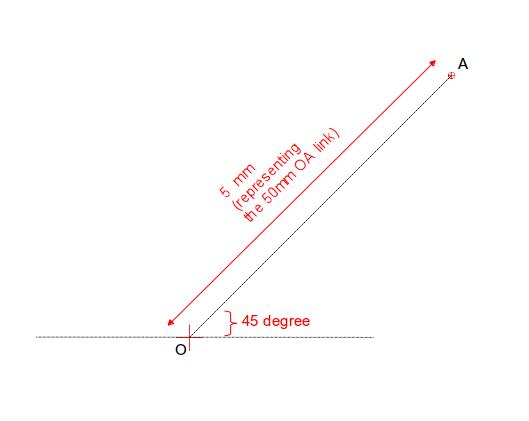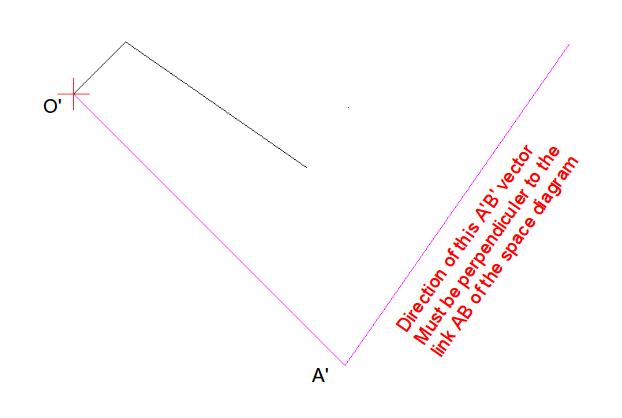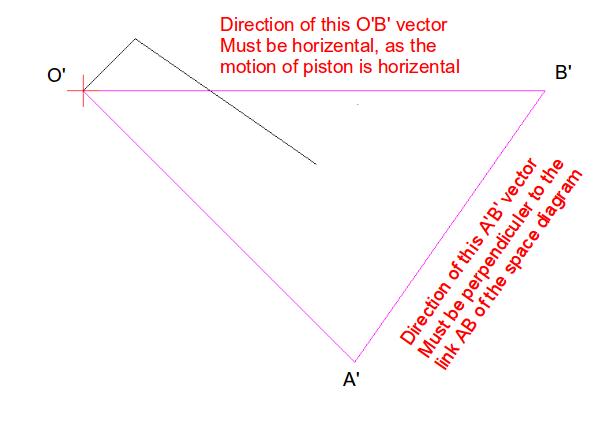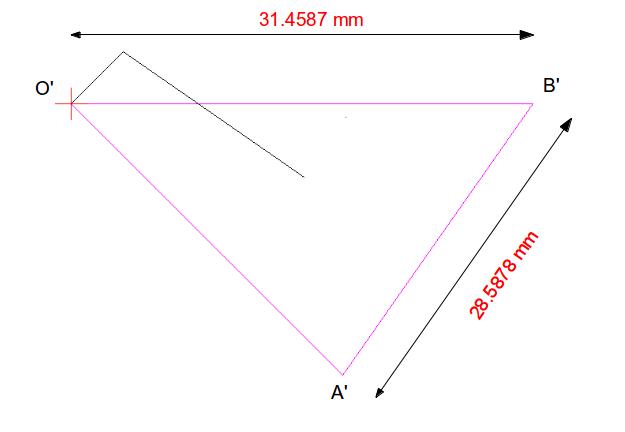The space diagram, velocity vector diagram and the acceleration vector diagram are the important tools for analyzing a mechanism.
With the help of the following example, i will explain the steps required to draw a typical velocity vector diagram.

Example:
The input data for the above four bar link mechanism is as below:
OA=50 mm
AB=150 mm
X=50 mm
Theta = 45 Degree
Speed of the link OA, Noa=5000 rpm
Upon completion of the velocity vector diagram, we will be able to analyze the four bar link to find out the absolute velocity of the piston B as well as the relative velocity of the piston B with respect to the joint A.
Required steps to produce the velocity diagram:
Step-1: Draw the space diagram: The space diagram is the “scaled” representation of the mechanism at the desired orientation of the links. We will use 0.1 scale factor here. So, the link OA will be represented by a 5 mm line starting from the point O at an angle of 45 degree (because theta=45 degree in our case) with horizontal.

At the end of the first step, you should get a line like OA (as shown above).
Step-2: Space diagram continued: Next draw the link AB starting from the point A of the already drawn line OA in such a way that the length of AB= 15 mm (remember we took a scale factor of 0.1mm). Also ensure that the distance between the two horizontal lines passing from the points O and B respectively is 5 mm (because X=50 mm and scale factor=0.1).

At the end of the step-2, you will get a space diagram consisting of the two lines OA and AB as shown above.
Step-3: calculating linear velocity of joint A:
We know the speed of the link OA =5000 rpm=(5000*2*3.14/60) rad/s =523.33 rad/s
We also know the length of OA=50 mm.
Further, to convert the angular velocity to the linear velocity, the following equation needs to be used:
Linear velocity = Angular velocity * Length of the link
So, linear velocity of joint A with respect to O, Voa =523.33*50 mm/s = 26166.67 mm/s
Step-4: Start drawing the velocity vector diagram: The linear velocity of the joint A will be perpendicular to the link OA and will start from the point O of the space diagram we have already drawn.
We will use a scale factor of 0.001 for drawing the velocity vector. Hence, a line of length 26.166 mm and perpendicular to the line OA of space diagram will represent the velocity vector Voa of value 26166.67 mm/s.

After finishing the Step-4, you should get the velocity vector O’A’ as shown above. Please observe the space diagram in the black colored line and velocity vector diagram in magenta colored line.
Step-5: Velocity vector diagram continued: The next thing we have to draw is the velocity vector
for the link AB.
We know two things about the velocity vector (we will represent it by A’B’), one, it will start from the point A’ of the velocity vector diagram and it will be perpendicular to the orientation of the link AB of the space diagram.
The thing we don’t know about the A’B’ is its value (or the linear velocity of the joint B with respect to the joint A).
So, for the time being we will just start the velocity vector A’B’ from the point A’ and to the direction perpendicular to the link AB and the velocity vector diagram at this stage will look like below:

Step-6 : Velocity vector diagram continued: Now we know the direction and the starting point of the link A’B’ , we have to find the other end of the vector. To find out the location of the other end, we will use the property of the joint B that it will always have the motion only in horizontal direction and will pass through the point O’(because the joint B is connected to the piston and the piston always oscillate in horizontal direction, and if you are wondering why the horizontal line should pass through the point O’ then the reason is by joining the horizontal line with the point O’ will give the velocity of the joint B with respect to the joint O). Now we have end up with the final velocity vector diagram of the mechanism:

Step-7: Calculate the unknown velocity values: Now if we measure the length of the line A’B’ and factored the value with the scale factor (0.001 in our case) , we will get the linear velocity of the joint B with respect to the joint A.

We are getting the length of the line A’B’ as 28.5878 mm. So for getting the velocity value of the joint B with respect to the joint A we have to divide it by the scale factor 0.001 and viola! We got the velocity value as 28587.8 mm/s.
Similarly we got the velocity of the piston (joint B) of the four bar linkage mechanism with respect to ground (or the joint O) as 31.4587/0.001 = 31458.7 mm/s.
Hi, I am Shibashis, a blogger by passion and an engineer by profession. I have written most of the articles for mechGuru.com. For more than a decades i am closely associated with the engineering design/manufacturing simulation technologies. I am a self taught code hobbyist, presently in love with Python (Open CV / ML / Data Science /AWS -3000+ lines, 400+ hrs. )

easy expain thanks mech guru.
pls how do i determine the sense of an angular velocity,from the velocity diagram whether clockwise or anti clock
wise
I’m so glad for having understand this chapter in a fraction of second… thanks a lot
I’m so glad for having understand this chapter in a fraction of second… thanks a lot